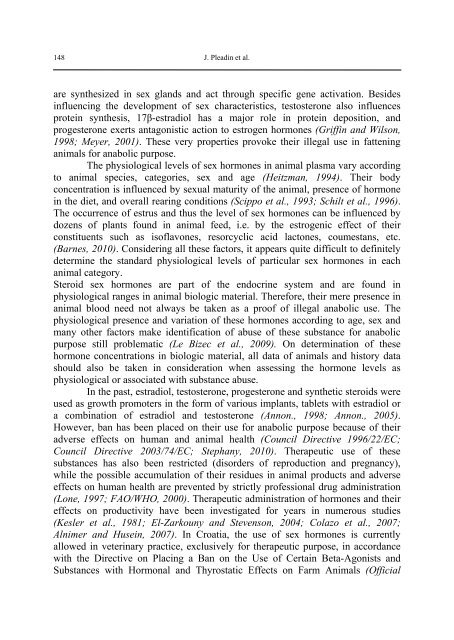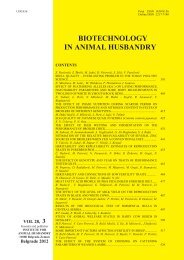Biotechnology in Animal Husbandry - Institut za Stočarstvo
Biotechnology in Animal Husbandry - Institut za Stočarstvo
Biotechnology in Animal Husbandry - Institut za Stočarstvo
You also want an ePaper? Increase the reach of your titles
YUMPU automatically turns print PDFs into web optimized ePapers that Google loves.
148<br />
J. Plead<strong>in</strong> et al.<br />
are synthesized <strong>in</strong> sex glands and act through specific gene activation. Besides<br />
<strong>in</strong>fluenc<strong>in</strong>g the development of sex characteristics, testosterone also <strong>in</strong>fluences<br />
prote<strong>in</strong> synthesis, 17β-estradiol has a major role <strong>in</strong> prote<strong>in</strong> deposition, and<br />
progesterone exerts antagonistic action to estrogen hormones (Griff<strong>in</strong> and Wilson,<br />
1998; Meyer, 2001). These very properties provoke their illegal use <strong>in</strong> fatten<strong>in</strong>g<br />
animals for anabolic purpose.<br />
The physiological levels of sex hormones <strong>in</strong> animal plasma vary accord<strong>in</strong>g<br />
to animal species, categories, sex and age (Heitzman, 1994). Their body<br />
concentration is <strong>in</strong>fluenced by sexual maturity of the animal, presence of hormone<br />
<strong>in</strong> the diet, and overall rear<strong>in</strong>g conditions (Scippo et al., 1993; Schilt et al., 1996).<br />
The occurrence of estrus and thus the level of sex hormones can be <strong>in</strong>fluenced by<br />
dozens of plants found <strong>in</strong> animal feed, i.e. by the estrogenic effect of their<br />
constituents such as isoflavones, resorcyclic acid lactones, coumestans, etc.<br />
(Barnes, 2010). Consider<strong>in</strong>g all these factors, it appears quite difficult to def<strong>in</strong>itely<br />
determ<strong>in</strong>e the standard physiological levels of particular sex hormones <strong>in</strong> each<br />
animal category.<br />
Steroid sex hormones are part of the endocr<strong>in</strong>e system and are found <strong>in</strong><br />
physiological ranges <strong>in</strong> animal biologic material. Therefore, their mere presence <strong>in</strong><br />
animal blood need not always be taken as a proof of illegal anabolic use. The<br />
physiological presence and variation of these hormones accord<strong>in</strong>g to age, sex and<br />
many other factors make identification of abuse of these substance for anabolic<br />
purpose still problematic (Le Bizec et al., 2009). On determ<strong>in</strong>ation of these<br />
hormone concentrations <strong>in</strong> biologic material, all data of animals and history data<br />
should also be taken <strong>in</strong> consideration when assess<strong>in</strong>g the hormone levels as<br />
physiological or associated with substance abuse.<br />
In the past, estradiol, testosterone, progesterone and synthetic steroids were<br />
used as growth promoters <strong>in</strong> the form of various implants, tablets with estradiol or<br />
a comb<strong>in</strong>ation of estradiol and testosterone (Annon., 1998; Annon., 2005).<br />
However, ban has been placed on their use for anabolic purpose because of their<br />
adverse effects on human and animal health (Council Directive 1996/22/EC;<br />
Council Directive 2003/74/EC; Stephany, 2010). Therapeutic use of these<br />
substances has also been restricted (disorders of reproduction and pregnancy),<br />
while the possible accumulation of their residues <strong>in</strong> animal products and adverse<br />
effects on human health are prevented by strictly professional drug adm<strong>in</strong>istration<br />
(Lone, 1997; FAO/WHO, 2000). Therapeutic adm<strong>in</strong>istration of hormones and their<br />
effects on productivity have been <strong>in</strong>vestigated for years <strong>in</strong> numerous studies<br />
(Kesler et al., 1981; El-Zarkouny and Stevenson, 2004; Colazo et al., 2007;<br />
Alnimer and Huse<strong>in</strong>, 2007). In Croatia, the use of sex hormones is currently<br />
allowed <strong>in</strong> veter<strong>in</strong>ary practice, exclusively for therapeutic purpose, <strong>in</strong> accordance<br />
with the Directive on Plac<strong>in</strong>g a Ban on the Use of Certa<strong>in</strong> Beta-Agonists and<br />
Substances with Hormonal and Thyrostatic Effects on Farm <strong>Animal</strong>s (Official




